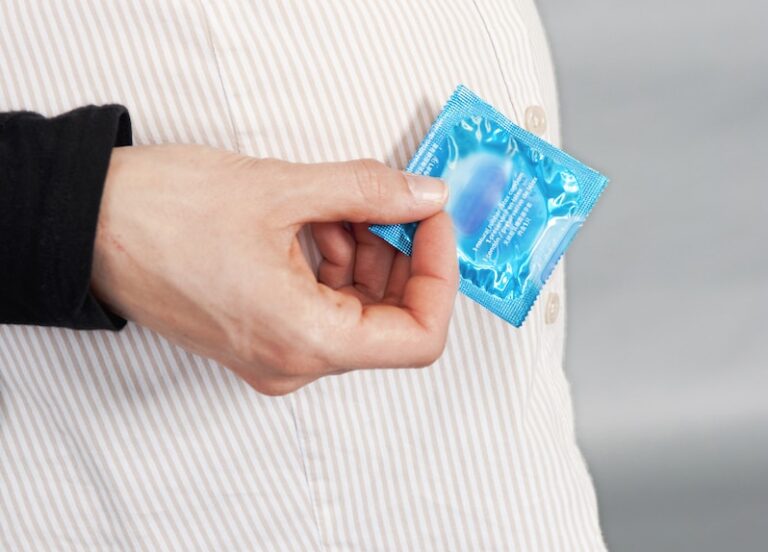When a condom breaks, it can be terrifying—especially when the break exposes both partners to sexually transmitted diseases and unwanted pregnancy. Fortunately, many condom breakages are preventable.
For example, it’s important to use water-based lube (not coconut oil, massage oils, body lotion or other products that contain oil) because oil degrades latex material.
1. Excessive Heat or Cold
The cold and heat can both weaken latex condoms, so you should keep yours in a cool dry place and avoid storing them in places like the glove compartment or wallet where they might be subject to extreme temperatures. Also, storing them near lotions or other oil-based products can cause the condom to break down faster.
Another reason a condom breaks is due to excessive wear and tear from improper use. If you don’t open the condom wrapper correctly (using teeth can create small punctures that could allow bacteria and sperm to get in), or if you roll it on too tightly, it can lead to a leak. Adding a little water or silicone-based lube to both the inside of the condom and the tip can help reduce the chances of this happening.
It’s also important to periodically check on the condom during intercourse to make sure it is still intact and not cracked, torn or missing pieces. If you do notice a break, it’s important to stop having sex and take precautions for pregnancy or sexually transmitted diseases until you are certain the problem is taken care of. Thankfully, the good news is that condoms are effective up to five days after possible conception—meaning that you and your partner can still avoid unintended pregnancy and STDs.
2. Lack of Lubrication
A condom that breaks in the middle of sex is not only embarrassing, but it exposes partners to body-to-body contact with sexual fluids, which increases risk of pregnancy and STIs. This is why it’s important to keep a stock of condoms handy and make sure to apply them correctly before sex.
But there are a few things that can cause your condom to break, even if you’re doing everything right. One is that you’re using an oil-based lubricant, which can degrade latex condoms. And another is that you aren’t using enough lubrication. Most condoms are lubricated, but it’s a good idea to use extra lube, especially for anal sex. That can help reduce friction between the penis and the inside of the condom, which can lead to a break.
You can also lose lubrication from sweating during sex, or by using too much pressure or force on the condom. And if you’re having anal sex, you’ll need extra lube to reduce friction between the anus and the condom because the anus doesn’t produce its own lubrication the way the vagina does. So keep a bottle of lube handy and apply it to both your anus and the condom before you start sex to prevent a condom break. And remember to check your condoms for leaks or microtears before you use them.
3. Not Enough Space
Some people store their condoms in their wallets or pants pockets for convenience, but this is a big no-no. When you put a condom in your pocket, the heat of your body transfers to the latex and it can break down over time. This doesn’t happen overnight, but over a period of months.
In addition to the degradation caused by the heat, storing your condoms in your pocket creates friction which can lead to breakage. You can avoid this by storing your condoms in a purse, wallet or small case that can be easily carried with you so that you always have one handy.
Condoms are best kept in a cool, dry place away from direct sunlight and extreme temperatures. Many people keep a box in their bathroom cabinet, but you can also keep them in your purse, wallet or man bag/messenger bag for on-the-go convenience.
When you use a condom, it’s important to leave a half-inch of space at the end for semen to collect. If you don’t leave enough space, the ejaculate can cause the condom to tear and you’ll have no protection against pregnancy and sexually transmitted diseases. To ensure that you have the proper amount of space, make sure that your condom is fully rolled down your penis and that you’re using enough lubrication, such as a water-based lubricant (K-Y Jelly or Astroglide works well) during anal or oral sex.
4. Not Using the Right Condom
We know it’s heart-stopping when a condom breaks during sex, but that doesn’t necessarily mean pregnancy or an STI is inevitable. A condom can be replaced with a new one, and you should always keep emergency contraceptives on hand.
The most common reason a condom breaks is because of improper use, according to a study. In up to 57 percent of the cases, people didn’t properly withdraw the condom after ejaculation. In addition, some people used inappropriate lubricants (including olive oil, cooking oil, baby oil, moisturizers, and body lotion), which can weaken the latex material.
Some people didn’t check the condom for holes or leaks, and that put them at risk for infection. Others didn’t wait long enough to switch to a new condom after the first break, and that increased their chances of experiencing another one later. Finally, a few people were using older condoms than the manufacturer recommended, which also increased their chances of pregnancy and sexually transmitted infections.
Using a condom correctly, proper withdrawal and storage, and adding lubrication are the best ways to prevent breakage. However, it’s still important to remember that even if a condom doesn’t break, pregnancy and STIs can still happen. That’s why it’s so important to visit your doctor after sex to get tested for any STIs and infections you may have picked up.
See Also:



